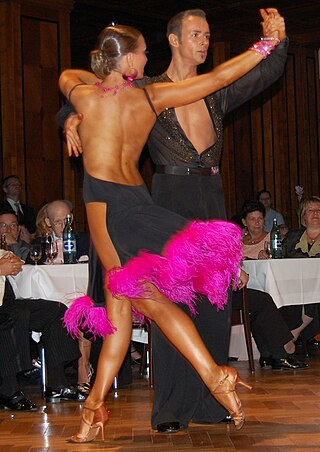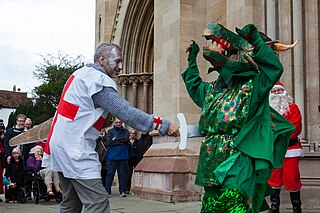Related Research Articles
The mazurka is a Polish musical form based on stylised folk dances in triple meter, usually at a lively tempo, with character defined mostly by the prominent mazur's "strong accents unsystematically placed on the second or third beat". The mazurka, alongside the polka dance, became popular at the ballrooms and salons of Europe in the 19th century, particularly through the notable works by Frédéric Chopin. The mazurka and mazurek are often confused in Western literature as the same musical form.

The term American folk music encompasses numerous music genres, variously known as traditional music, traditional folk music, contemporary folk music, vernacular music, or roots music. Many traditional songs have been sung within the same family or folk group for generations, and sometimes trace back to such origins as the British Isles, Mainland Europe, or Africa. Musician Mike Seeger once famously commented that the definition of American folk music is "...all the music that fits between the cracks."

Cajun music, an emblematic music of Louisiana played by the Cajuns, is rooted in the ballads of the French-speaking Acadians of Canada. Although they are two separate genres, Cajun music is often mentioned in tandem with the Creole-based zydeco music. Both are from southwest Louisiana and share French and African origins. These French Louisiana sounds have influenced American popular music for many decades, especially country music, and have influenced pop culture through mass media, such as television commercials.

Partner dances are dances whose basic choreography involves coordinated dancing of two partners, as opposed to individuals dancing alone or individually in a non-coordinated manner, and as opposed to groups of people dancing simultaneously in a coordinated manner.
Troika or troyka may refer to:

Troika Games was an American video game developer co-founded by Jason Anderson, Tim Cain, and Leonard Boyarsky. The company was focused on role-playing video games between 1998 and 2005, best known for Arcanum: Of Steamworks and Magick Obscura and Vampire: The Masquerade – Bloodlines.
NKVD troika or Special troika, in Soviet history, were the People's Commissariat of Internal Affairs made up of three officials who issued sentences to people after simplified, speedy investigations and without a public trial. The three members were judge and jury, though they themselves did not carry out the sentences they dealt. These commissions were employed as instruments of extrajudicial punishment introduced to supplement the Soviet legal system with a means for quick and secret execution or imprisonment. It began as an institution of the Cheka, then later became prominent again in the NKVD, when it was used during the Great Purge to execute many hundreds of thousands of Soviet citizens. Defendants in the Troika's proceeding were typically not entitled to legal aid or the presumption of innocence. Convictions usually did not include information about the actual incriminating evidence and basically contained only information about indictment and sentencing. The outcome of such trials was often determined before it even began due to targeted numbers of citizens to be executed or imprisoned in Gulag prison camps.

Troika was an art pottery that operated in Cornwall from 1962 to 1983. It was founded by three people, Leslie Illsley, Jan Thompson and Benny Sirota who took over the Powell and Wells Pottery at Wheal Dream, where Sirota had previously worked as a decorator and driver. The name is from the Russian тройка, meaning "a set of three", or triumvirate.

Ella Yuryevna Kagan, known as Elsa Triolet(Russian: Эльза Триоле) was a Russian-French writer and translator.

The term Creole music is used to describe both the early folk or roots music traditions of rural Creoles of Louisiana.

The Troika is an amusement park ride designed and manufactured by HUSS Park Attractions in the mid-1970s. The name Troika means "group of three" in Russian, a reference to its three armed design. There are several variations on the design.

Cajun English, or Cajun Vernacular English, is a dialect of American English spoken by Cajuns living in Southern Louisiana. Cajun English is significantly influenced by Louisiana French, the historical language of the Cajun people, a subset of Louisiana Creoles — although many today prefer not to identify as such — who descend largely from the Acadian people expelled from the Maritime provinces during Le Grand Dérangement.

Georgian dance is the traditional dance of Georgia. It stems from military moves, sports games, and dances celebrated during holidays in the Middle Ages. The dance was popularized by the founders of the Georgian National Ballet, Iliko Sukhishvili, and his wife, Nino Ramishvili,

The Courir de Mardi Gras is a traditional Mardi Gras event held in many Cajun and Creole communities of French Louisiana on the Tuesday before Ash Wednesday. Courir de Mardi Gras is Louisiana French for "Fat Tuesday Run". This rural Mardi Gras celebration is based on early begging rituals, similar to those still celebrated by mummers, wassailers, and celebrants of Halloween. As Mardi Gras is the celebration of the final day before Lent, celebrants drink and eat heavily, dressing in specialized costumes, ostensibly to protect their identities. In Acadiana, popular practices include wearing masks and costumes, overturning social conventions, dancing, drinking alcohol, begging, trail riding, feasting, and whipping. Mardi Gras is one of the few occasions when people are allowed to publicly wear masks in Louisiana. Dance for a Chicken: The Cajun Mardi Gras, a documentary by filmmaker Pat Mire, provides great insight into the history and evolution of this cultural tradition. In popular culture, two HBO series also make reference to the tradition.

A troika is a traditional Russian harness driving combination, using three horses abreast, usually pulling a sleigh. It differs from most other three-horse combinations in that the horses are harnessed abreast. The middle horse is usually harnessed in a horse collar and shaft bow; the side horses are usually in breastcollar harness. The troika is traditionally driven so that the middle horse trots and the side horses canter; the right-hand horse will be on the right lead and the left-hand horse on the left lead. The troika is often claimed to be the world's only harness combination with different gaits of the horses.

In folklore, a hobby horse is a costumed character that features in some traditional seasonal customs, processions and similar observances around the world. In England, they are particularly associated with May Day celebrations, mummers' plays and the Morris dance.

Folk dance of Mexico, commonly known as baile folklorico or Mexican ballet folk dance, is a term used to collectively describe traditional Mexican folk dances. Ballet folklórico is not just one type of dance, it encompasses each region's traditional dance that has been influenced by their local folklore and has been entwined with ballet characteristics to be made into a theatrical production. Each dance represents a different region in Mexico illustrated through their different zapateado, footwork, having differing stomps or heel toe points, and choreography that imitates animals from their region such as horses, iguanas, and vultures.

Russian folk dance is an important part of Russian culture. Some of the unique characteristics suggest that many elements were developed by the early Russian population.

Mummers' plays are folk plays performed by troupes of amateur actors, traditionally all male, known as mummers or guisers. Historically, mummers' plays consisted of informal groups of costumed community members that visited from house to house on various holidays. Today the term refers especially to a play in which a number of characters are called on stage, two of whom engage in a combat, the loser being revived by a doctor character. This play is sometimes found associated with a sword dance though both also exist in Britain independently.
References
- ↑ "Triolet" (in Russian). Archived from the original on 15 May 2018. Retrieved 28 August 2011.
- ↑ Кузнецов, Е. А., Влияние творческого наследия мастеров народного танца на формирование эстетического вкуса у студентов хореографических специализаций
- ↑ тройка, Ozhegov's Explanatory Dictionary
- ↑ Русский народный танец "Тройка" ] [4dancing.ru/blogs/200914/1883/][ better source needed ]
- ↑ Cajun Dancing, 1993, ISBN 1455601764, p. 139
- ↑ Контрдансы ХІХв./Контрдансы ХІХв. : Triolet, modern reconstruction based on the book, Eduard Helmke, Neue Tanz- und Bildungsschule, 1829